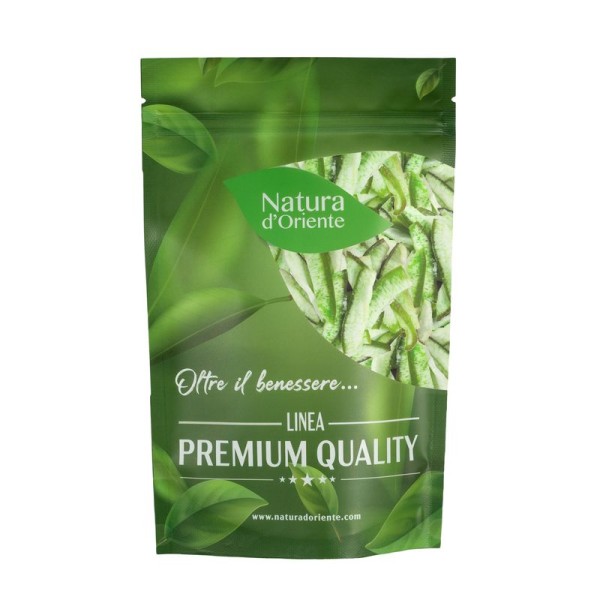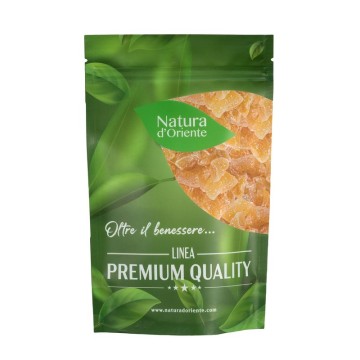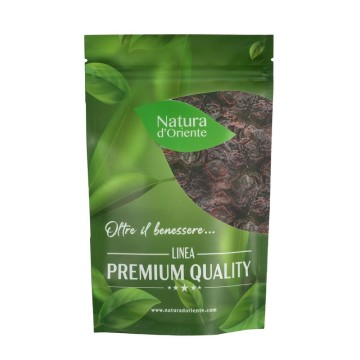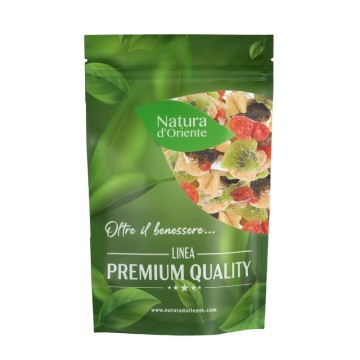Dehydrated green pomelo
The pomelo is an unusual fruit, which is part of the citrus family of which it can be considered one of the founders. It has a surprising number of health benefits for people ... willing to seek it out! It is not always present in local markets and tables, but it is easily available in its version of dehydrated pomelo.
Dried Green Pomelo: properties and benefits
First of all, you need to learn more about pomelo, a great Asian citrus fruit. It has the shape similar to that of a pear, with a green or yellow pulp and a thick, clear skin.
In flavor, pomelo tastes similar to grapefruit, but is sweeter. Its beneficial properties derive from the different vitamins, minerals and antioxidants contained; elements that make it a healthy addition to the diet.
First of all, it is a good source of vitamin C which we know is a powerful antioxidant, capable of strengthening the immune system and preventing cell damage from free radicals.
Pomelo is also rich in other vitamins (such as vitamin B6), magnesium and minerals, including potassium, which helps regulate fluid balance in the body and blood pressure.
A dehydrated pomelo offers a lot of fiber, and is an excellent fruit to help you meet your needs for insoluble fiber, which helps prevent constipation.
Dietary fiber also serves as a food source for healthy bacteria in the gut to keep the gut biome in perfect balance. Fruit fiber, such as that of green pomelo, has been associated with improved bowel functions.
In addition, it contains proteins and fibers, which can induce feelings of satiety, for the purpose of a weight loss diet. Dehydrated green pomelo can contribute to weight loss, including by absorbing and reducing the sugar and starch content in the body.
It is a fruit rich in antioxidants , in particular besides vitamin C the main antioxidants of pomelo are naringenin and naringin. Both substances are present in citrus fruits, but pomelos contain lycopene, an antioxidant that fights inflammation, also found in tomatoes.
These antioxidants may be beneficial to the heart by regulating cholesterol and triglyceride levels, two blood fats that are linked to heart disease - according to some ongoing research, they could prevent the cholesterol in food from being fully absorbed into the body.
Due to its high antioxidant content, pomelo can help prevent skin damage caused by harmful free radicals, helping you to maintain a more youthful appearance. Additionally, essential oil from pomelo peel can reduce the production of melanin in the skin, helping it to prevent sun spots.
The good levels of minerals and vitamins, such as magnesium and potassium, also help athletes to replenish the substances lost during physical exertion and reduce cramps.
Origins and History of cultivation
Native to southern Asia and Malaysia, where it has been known for more than four thousand years, the pomelo citrus was introduced to China around the 1st century AD. From there it spread and continues to survive. Also growing spontaneously, in the wild, along the banks of rivers and streams, in various territories including Tonga, Hawaii and Fiji.
Pomelo has many names in the world including Citrus maxima, Citrus grandis, Chinese grapefruit, pommelo, boongon, Jeruk Bali, jabong, shaddock, Jeruk Bali, pomelo, pummelo, pampaleone. It has often been confused with yuzu, a Chinese fruit that is actually of a different species.
Always assimilated to grapefruit, it is larger, has a sweet pulp, a thick and spongy skin, and its color ranges from light green to yellow when ripe. For this reason, we can define the dehydrated green pomelo, with a very specific color.
The color of its pulp varies from light yellow to pink or red, while for centuries the peel of the pomelo has been used to make jam, and in Chinese cuisine or used as a sweetener to make candies.
Nowadays, pomelo is mainly grown in China and southern India, Thailand, the Philippines, and other eastern and tropical countries (in Southeast Asia). It hasn't become very popular as a crop in many parts of the world because it takes 8 years for the seeds to start flowering and fruiting.
A curiosity: the pomelo is also known as shaddock, named after the English captain Shaddock, who introduced the pomelo seed from the Malay archipelago to the West Indies, in the 17th century. The captain is also remembered in Liguria, where the pomelo is known as sciaddocco, while in Italia is grown in Sicily.
Although much of the pomelo is inedible, while only the inner pulp is palatable, it is highly coveted for nutritional value.
Plant and Fruit
 The plant of the Pomelo Verde botanically is the Citrus maxima or Citrus grandis , native to China. It is considered one of the three species from which all citrus fruits are derived, such as cedar and mandarin.
The plant of the Pomelo Verde botanically is the Citrus maxima or Citrus grandis , native to China. It is considered one of the three species from which all citrus fruits are derived, such as cedar and mandarin.
The plant is resistant to frost, but grows best in warm and rainy climates, in fact, tropical and subtropical areas with humid and marshy soils are ideal for growing it. The pomelo propagates mainly by grafting.
It is very vigorous, thorny, with large, elliptical-oval leaves. The flowers are large, arranged both in clusters and isolated.
Donate the pomelo fruit, which grows up to 30 centimeters in diameter and can weigh up to 10 kilograms. It has a green-yellow and sometimes pinkish skin, and a spongy white substance under the skin, called albedo. This forms the entire upper part of the fruit, the narrow part.
The shape of the pomelo, in fact, is not spherical, but looks like a pear shape (in some countries the shape is assimilated to a tear).
The pulp reaches colors from straw yellow to pink to red, and gives a flavor similar to grapefruit but sweeter.
Pomelo is mainly used as a table fruit, or the juice is used.
Remember that like all citrus fruits it is a winter fruit, the pomelo season lasts from September to January. The availability is not easy, but the version of the dried pomelo allows you to have this fruit all year round.
Nutritional values of dehydrated Green Pomelo
This dehydrated fruit contains about 350 Kcal per 100 grams, does not contain fat, provides minerals, vitamins and fiber .
The nutritional properties of the dehydrated Green Pomelo show excellent levels of vitamin C (about 60 mg / 100 g) and vitamin A (IU 8). In the dried version, Pomelo Verde also contains vitamin substances which per 100 grams are: Thiamine (about 0.035 mg), Riboflavin (about 0.27 mg) and Niacin (about 0.22 mg), Vitamin B-6 (about 0.36 mg).
In addition, it makes available minerals such as potassium (about 200 mg / 100g), calcium (about 4 mg / 100 g), magnesium (about 6 mg / 100 g), phosphorus (about 17 mg / 100 g ) and zinc (about 0.08 mg / 100 g).
How to consume dehydrated Green Pomelo in the kitchen or as a snack
For centuries this fruit has been widely used in Southeast Asian cuisine, for its pleasantly aromatic citrus taste, without the sour taste you will find in a grapefruit.
It can be used in salads or to enhance the flavor of a soup, but it is often associated with desserts by inserting pomelo in fruit or legume salads, and as a garnish for duck and chicken dishes , pork and shrimp.
The sliced version of dehydrated green pomelo is perfect as a hunger breaker , or to be added to fruit and cereal mixes, to create top toppings for ice cream, muffins, cakes, cupcakes and other sweets.
Dried Green Pomelo is also ideal for making energy bars, or to be added as an ingredient to yogurt, tea and infusions.
Dried Green Pomelo can also be used to garnish smoothies or cocktails, which become original and exotic.
Dried Green Pomelo: side effects and contraindications
There are no particular contraindications to taking Green Pomelo in the correct doses. We know, however, that like other nuts, pomelo contains sugar , which is not recommended for people with diabetes - it can raise blood sugar levels.
Also, like grapefruits, pomelos contain compounds called furanocoumarins , which can affect the metabolism of statins - to be evaluated for those taking drugs that affect this metabolism.
Furthermore, in high quantities it could interact with antiarrhythmic drugs, corticosteroids, calcium antagonists, immunosuppressants and protease inhibitors.
In large doses, the dried Green Pomelo could cause problems for those suffering from gastritis.













 No reward points for this product.
No reward points for this product.
 The plant of the Pomelo Verde botanically is the Citrus maxima or Citrus grandis , native to China. It is considered one of the three species from which all citrus fruits are derived, such as cedar and mandarin.
The plant of the Pomelo Verde botanically is the Citrus maxima or Citrus grandis , native to China. It is considered one of the three species from which all citrus fruits are derived, such as cedar and mandarin.














